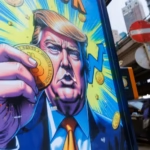With nearly a month remaining before the crucial deadline for the United States and China to negotiate an agreement in their ongoing trade dispute, recent developments suggest a significant deterioration in relations between the two nations. China’s recent announcement of renewed restrictions on the export of critical minerals has led U.S. President Donald Trump to respond with a dramatic tariff increase of 100% on Chinese exports heading to the U.S., effectively undermining hopes for averting further global economic instability.
On Thursday, the Chinese commerce ministry disclosed heightened export restrictions on rare earth elements, citing national security issues as a primary concern. This move has reignited tensions, given China’s dominant position in the global rare earth supply chain—producing over 90% of the processed rare earths and controlling around 70% of the world’s mining operations. Rare earth metals are vital for manufacturing a wide array of products, from consumer electronics to military hardware.
In response to these restrictions, Trump labeled China’s actions as “extremely hostile” and announced the implementation of sweeping tariffs on Chinese imports. Current statistics show U.S. tariffs on Chinese goods have surged to an average of 58%, while Chinese tariffs stand at 33%. Although discussions have hinted at potential tariffs reaching nearly 150%, these plans remain on hold ahead of a looming November 10 deadline for negotiations.
This escalation was not entirely unexpected; it follows last month’s U.S. decision to impose stricter controls on the export of chipmaking equipment to China, aimed at limiting advancements in Chinese semiconductor technology. Beijing’s previous restrictions on rare earth exports, which occurred in April, led to global manufacturing slowdowns before they were temporarily lifted.
Experts suggest that this tactic may reflect Beijing’s attempt to reset negotiations, with some analysts viewing it as a strategy to escalate pressure on the U.S. rather than merely responding to prior provocations. Hutong Research, an independent advisory firm, noted that Beijing appears to be revisiting its earlier strategy to compel negotiation rather than waiting for talks to resume passively.
While there had been recent signs of improvements in U.S.-China relations—such as a deal reached regarding TikTok and a rare visit by U.S. lawmakers to China—swiftly changing dynamics have brought new complications to the forefront. The TikTok agreement, seen as a win-win solution, had provided a brief moment of optimism, but ongoing tensions over access to chip technology and Chinese purchases of Russian oil contribute to a complex backdrop that continues to strain bilateral ties.
The anticipated engagement between Trump and Chinese President Xi Jinping, initially slated during the upcoming APEC summit in South Korea, has become uncertain following the recent turbulence. Trump himself indicated via social media that he was now reassessing the purpose of the planned meeting.
The repercussions of these developments have significantly affected global markets. Following Trump’s announcement of the 100% tariffs, the S&P 500 Index experienced a notable decline of over 2%, marking one of its most substantial single-day drops since April. Some market analysts speculate that the negative market response could exert pressure on Trump to reconsider his tariff stance.
In the face of these rapidly evolving circumstances, attention now turns to Beijing, where a statement from the commerce ministry indicated that China would take “resolute measures to protect its legitimate rights and interests.” This raises the possibility of retaliatory tariffs or decisions regarding existing agreements, such as the one concerning TikTok, which could have far-reaching political ramifications beyond simple tariff disputes.






